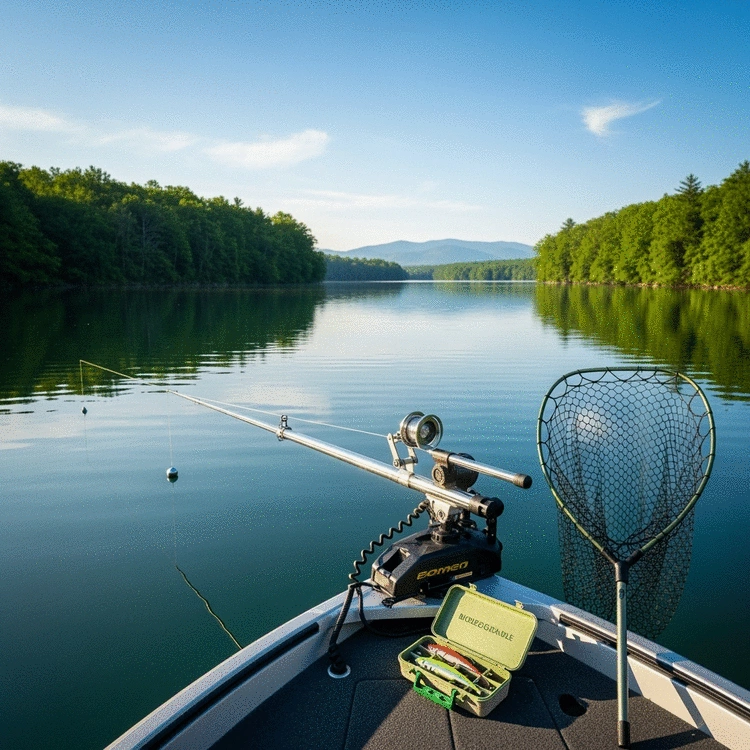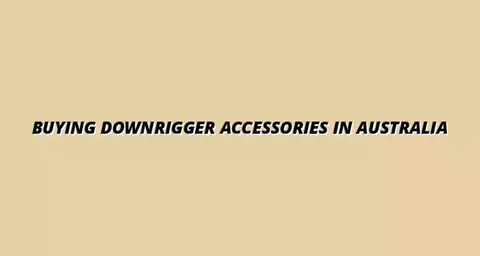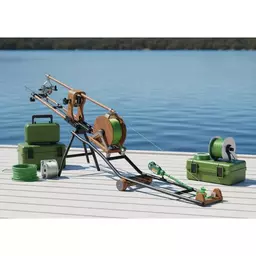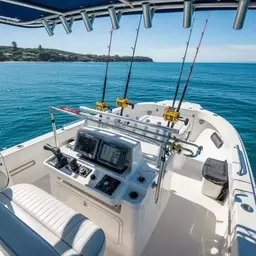Have you ever considered how your fishing practices might impact the very ecosystems you enjoy? Embracing sustainable downrigger fishing techniques not only enhances your experience but also preserves the marine environments for future generations. Here’s what you’ll learn about fishing responsibly.
What You Will Learn
- Sustainable downrigger fishing minimizes ecological impact while maximizing catch potential.
- Using lead-free alternatives protects aquatic life and reduces pollution.
- Opting for biodegradable gear helps lessen marine debris and supports healthier ecosystems.
- Employing effective techniques to reduce bycatch is essential for sustainable fishing.
- Understanding local fish species and their habitats leads to more responsible fishing practices.
- Utilizing technology like sonar and GPS enhances fishing efficiency while protecting marine habitats.
- Community engagement in sustainability initiatives fosters shared responsibility among anglers.
Process Flow: Sustainable Downrigger Fishing Practices
This visual outlines the key practices and their benefits for minimizing environmental impact and maximizing catch responsibly.
Minimizing Environmental Impact
1. Lead-Free Alternatives
- Reduces lead poisoning.
- Cleaner waters.
2. Biodegradable Gear
- Minimizes pollution.
- Healthier ecosystems.
3. Reducing Bycatch
- Protects non-target species.
- Targeted fishing.
Maximizing Catch Responsibly
1. Species-Specific Tactics
- Research local species.
- Custom gear adjustments.
2. Effective Downrigger Setup
- Choose right weight.
- Adjust depth accurately.
- Set up bait.
3. Utilizing Technology
- Sonar for fish location.
- GPS tracking.
Community & Compliance
1. Gear Recommendations
- Scotty/Cannon Downriggers.
- Eco-friendly weights.
2. Community Initiatives
- Clean-ups & Certifications.
- Local fishing clubs.
3. Local Regulations
- Stay updated on laws.
- Respect quotas.
Benefits & Future Impact
1. Conservation of Resources
- Preserves fish stocks.
- Ensures future fishing.
2. Habitat Protection
- Minimizes ecosystem disruption.
- Maintains biodiversity.
3. Community Engagement
- Fosters responsible anglers.
- Educates others.
Sustainable Downrigger Fishing: Eco-Friendly Techniques for Big Catches
Sustainable downrigger fishing is not just a trend; it’s an essential approach to preserving our beautiful marine ecosystems while still enjoying the thrill of the catch! At Downrigger Insights, I deeply believe that we can enhance our fishing experiences without compromising the environment. By adopting sustainable techniques, we ensure that future generations of anglers can also enjoy the rich aquatic diversity that Australia offers.
But what exactly is sustainable downrigger fishing? It refers to the methods and practices that minimize ecological impact while maximizing your catch potential. This fishing style emphasizes responsible gear choices, habitat conservation, and the well-being of fish populations, allowing us to fish ethically and effectively.
Understanding Sustainable Downrigger Fishing
When we talk about sustainable downrigger fishing, the goal is to reduce our footprint on the environment while still enjoying our time on the water. This approach involves selecting equipment and methods that protect marine habitats and fish populations. It is crucial for maintaining biodiversity and ensuring that fishing remains a viable activity for years to come.
- Conservation of Resources: By using sustainable techniques, we help preserve fish stocks for future fishing trips.
- Habitat Protection: Prioritizing methods that minimize disruption to marine ecosystems is vital for health.
- Community Engagement: Sustainable fishing fosters a sense of community among anglers who care about their environment.
The practices we adopt today will have a lasting impact on the health of our waters. That's why it’s important to educate ourselves and others about the best methods in sustainable downrigger fishing.
Minimizing Environmental Impact: Key Practices
Choosing Lead-Free Alternatives
One of the most significant changes we can make is switching to lead-free weights. These alternatives not only help reduce pollution but also protect aquatic life from lead poisoning. For instance, a study published in PMC highlights the detrimental effects of lead on wildlife, making lead-free options a crucial step towards responsible angling. By choosing materials like steel or tungsten, we are making a conscious decision to fish responsibly.
- Health Benefits: Reduces risks of lead exposure for both fish and humans.
- Durability: Many lead-free alternatives are more durable, providing better value over time.
- Environmental Protection: Using non-toxic materials contributes to cleaner waters.
Using lead-free options is not just a choice; it’s a responsibility that every angler should embrace to protect our marine environments.
Biodegradable Gear: An Essential Shift
As we strive for sustainability, opting for biodegradable fishing gear is a crucial step. This type of equipment breaks down naturally, reducing the long-lasting impacts that traditional plastics have on marine life.
- Less Waste: Biodegradable materials decompose, minimizing pollution in our rivers and oceans.
- Eco-Friendly Choices: Many companies are now offering eco-friendly options that meet anglers' needs.
- Positive Impact: By using biodegradable gear, we contribute to healthier ecosystems.
Such shifts in gear choices can lead to a significant reduction in marine debris, supporting the overall health of our fishing grounds.
Reducing Bycatch: Techniques and Tools
Reducing bycatch is vital for protecting non-target species and ensuring that we fish sustainably. Employing techniques such as proper downrigger setups and using specialized lures can significantly decrease the chances of accidentally catching unwanted species.
- Species Selection: Use lures and bait that target specific species, minimizing unwanted catches.
- Depth Adjustments: Modify your downrigger depth based on the species you are targeting.
- Time of Day: Fish at times when your target species is most active to improve success rates.
By being mindful of our practices, we can enjoy successful fishing trips while preserving the delicate balance of aquatic life.
Maximizing Your Catch Responsibly
Species-Specific Tactics for Sustainable Fishing
Understanding local fish species and their habitats is key to sustainable fishing. By tailoring your approach based on specific species, you can maximize your catch while minimizing environmental impact. For example, if targeting snapper, knowing their preferred depths and feeding habits can yield better results! This approach aligns with broader efforts to improve sustainable fisheries management, as seen in community-powered initiatives.
- Research Local Species: Familiarize yourself with the habits and habitats of the fish you’re after.
- Custom Gear Adjustments: Modify your downrigger setup based on the species’ behavior.
- Seasonal Considerations: Different seasons can affect fish availability and behavior.
Always remember, being informed leads to better fishing practices and more responsible outcomes.
Effective Downrigger Setup and Deployment
Setting up your downrigger effectively is crucial for sustainable fishing. A well-optimized downrigger can significantly improve your chances of landing a target species while minimizing bycatch.
- Choose the Right Weight: Select an appropriate weight based on water conditions and target depth.
- Adjust Depth Accurately: Use a depth finder to ensure your bait is at the optimal level for your target.
- Set Up Your Bait: Ensure your bait mimics the natural prey of the species you are targeting.
This systematic approach not only improves your catch rates but also aligns with sustainable practices, ensuring that we respect our marine resources.
Utilizing Technology for Eco-Friendly Fishing
Modern technology plays a significant role in facilitating eco-friendly fishing practices. Tools like sonar and GPS can help us locate fish efficiently without disturbing their habitats.
- Sonar Technology: Provides insights into fish locations, allowing for more targeted fishing.
- GPS Tracking: Helps identify hotspots while keeping track of areas that should be avoided.
- Monitoring Water Conditions: Advanced tools give us real-time data about water temperatures and currents, optimizing our fishing strategies.
By integrating technology into our fishing practices, we can reduce our environmental impact and enhance our overall fishing experience.
Gear Recommendations for Sustainable Downrigger Fishing
Top Eco-Friendly Downriggers and Accessories
When it comes to sustainable downrigger fishing, the right gear is essential. Here are some of my top recommendations for eco-friendly downriggers and accessories:
- **Scotty Downriggers:** Known for their durable, lead-free materials.
- **Cannon Downriggers:** Offer a range of eco-conscious options.
- **Eco-Friendly Weights:** Look for brands that provide biodegradable alternatives.
Choosing the right equipment is a step towards responsible fishing practices and ensures that we can continue enjoying our beloved pastime without harming the environment.
Community Initiatives and Sustainable Certifications
Engaging with local and global initiatives that promote eco-friendly fishing practices is a fantastic way to contribute to sustainability efforts. Organizations like Australian Marine Conservation Society are leading the way in advocating for responsible fishing.
- Community Clean-Ups: Participate in local clean-up events to help preserve our fishing habitats.
- Sustainable Fishing Certifications: Support brands that are certified for their sustainable practices.
- Join Local Fishing Clubs: Connect with like-minded anglers dedicated to sustainability.
By participating in these initiatives, we not only learn more about sustainable practices but also foster a community that values and protects our marine environments.
Frequently Asked Questions (FAQs)
Q1: What is sustainable downrigger fishing?
A1: Sustainable downrigger fishing involves methods and practices that minimize ecological impact and maximize catch potential, emphasizing responsible gear choices, habitat conservation, and fish population well-being.
Q2: Why should I switch to lead-free weights?
A2: Switching to lead-free weights reduces pollution and protects aquatic life from lead poisoning, contributing to cleaner waters and healthier ecosystems.
Q3: How does biodegradable gear help the environment?
A3: Biodegradable gear breaks down naturally, minimizing long-lasting pollution from plastics in marine environments and supporting overall ecosystem health.
Q4: What are some techniques to reduce bycatch?
A4: Techniques include using species-specific lures and bait, adjusting downrigger depth based on target species, and fishing at times when your target species is most active.
Q5: How can technology improve sustainable fishing?
A5: Technology like sonar and GPS helps locate fish more efficiently, allowing for targeted fishing and reducing disturbance to marine habitats, while also providing data on water conditions.
Q6: Why is understanding local fish species important for sustainable fishing?
A6: Understanding local species' habits and habitats allows anglers to tailor their approach, maximizing catch potential for target species while minimizing environmental impact and bycatch.
Understanding Fish Populations and Biodiversity
Maintaining healthy fish populations and biodiversity is crucial for the longevity of our fishing communities. Overfishing and habitat destruction can lead to severe declines in species, disrupting the balance of aquatic life. Research, such as that on sustainable fisheries management, further emphasizes the importance of these practices for marine sustainability.
As anglers, we have a responsibility to practice sustainable fishing techniques that contribute to the health of fish populations. Let's aim to leave a thriving ecosystem for future generations of anglers!
Impact of Aquaculture on Sustainable Fishing
Aquaculture can play a double role in sustainable fishing. When done responsibly, it can alleviate pressure on wild fish populations. However, poor practices can lead to negative consequences for marine ecosystems.
- Support Responsible Farms: Choose seafood from sustainably managed aquaculture operations.
- Understand Practices: Educate yourself on the impacts of aquaculture on surrounding ecosystems.
- Promote Local Initiatives: Encourage local efforts that focus on sustainable fish farming.
By understanding the impact of aquaculture, we can make informed decisions that align with our sustainable fishing goals.
Local Regulations and Best Practices
It's vital to understand local fishing regulations, as they often reflect sustainability efforts in your area. Staying informed ensures that we comply with laws designed to protect marine resources.
By following these regulations, we can contribute to the conservation of our aquatic environments and promote responsible fishing practices in our communities.
Compliance and Responsibility in Fishing
Ensuring compliance with environmental guidelines while fishing is not just a legal obligation; it's a personal responsibility. Here are some best practices to consider:
- Stay Updated: Regularly check for updates on fishing regulations and sustainable practices.
- Respect Quotas: Adhere to catch limits to help maintain fish populations.
- Educate Others: Share knowledge with fellow anglers about sustainable fishing techniques.
By being proactive, we contribute to a culture of sustainability that benefits our oceans and those who share in the joy of fishing.
Did You Know?
According to a study by the Australian Marine Conservation Society, sustainable fishing practices can help restore fish populations by up to 30% over a decade. By making responsible choices today, we can ensure thriving aquatic ecosystems for future generations!
Summarizing Sustainable Downrigger Fishing Practices
As we reflect on the essential techniques of sustainable downrigger fishing, it becomes clear how vital these practices are for preserving our precious marine life. By adopting eco-friendly methods, we not only enhance our fishing experiences but also contribute to the health of our oceans. Remember, fishing is not just a hobby; it's a responsibility that we share with the environment.
Incorporating techniques such as using lead-free alternatives, biodegradable gear, and efficient bycatch reduction methods can significantly reduce our impact on aquatic ecosystems. Each small effort counts!
Call to Action: Embrace Sustainability in Your Fishing Adventures
Now is the time to take action! I encourage all anglers to embrace sustainable fishing practices. Here are a few simple steps you can take:
- Educate yourself on local species and their habitats.
- Invest in eco-friendly gear that minimizes pollution.
- Share your successes and challenges with fellow fishers.
- Participate in local clean-up events or workshops to promote sustainability.
By making these changes, we can ensure that our fishing adventures are not just enjoyable, but also beneficial for the environment. Let’s work together to create a fishing community that values sustainability!
Engaging with the Community for Better Practices
Getting involved in discussions and events focused on sustainable fishing can greatly enhance our collective knowledge. Here’s how you can engage:
- Join local fishing clubs or online forums dedicated to sustainability.
- Attend workshops hosted by experts in sustainable fishing practices.
- Share your fishing experiences, tips, and techniques with others.
- Collaborate with local conservation groups on initiatives that benefit marine ecosystems.
Together, we can build a stronger community committed to the health of our waters. If you have stories or tips about your sustainable fishing journey, I’d love to hear from you! Let’s connect and make a lasting positive impact on Australia’s marine environments.
Recap of Key Points
Here is a quick recap of the important points discussed in the article:
- Conservation of Resources: Use sustainable techniques to preserve fish stocks for future trips.
- Lead-Free Alternatives: Opt for materials like steel or tungsten to reduce pollution and protect aquatic life.
- Biodegradable Gear: Choose equipment that breaks down naturally to minimize long-term environmental impacts.
- Reducing Bycatch: Implement techniques like proper lure selection and depth adjustments to minimize unwanted catches.
- Engagement in Community Initiatives: Participate in local efforts to promote sustainable practices and join fishing clubs dedicated to conservation.
- Stay Informed: Keep updated on local fishing regulations to ensure compliance and contribute to marine resource preservation.







